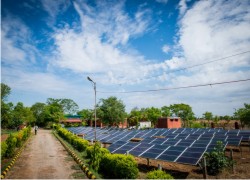|
Resource Efficiency for Sustainable Wellbeing of All
For
centuries, our development and economic prosperity has depended on
production of more and more goods and services. This has led to an
ever-growing consumption of natural resources, which in turn has
required an ever-increasing extraction and depletion of these resources
from Mother Earth. The emerging results are severe threats to nature’s
capacity to yield (let alone regenerate) the resources we need such as
water, metals, minerals, fossil fuels, fish stock, arable soils,
wildlife and the diminution of our forests, soils and rivers. The
extraction, transportation, processing and use of resources is highly
energy-consuming and this activity is a very large contributor to carbon
emissions and climate change. Furthermore, rapidly expanding extraction
and use of resources is the single greatest cause of biodiversity loss
and desertification, not to mention the clouds of toxic pollution and
mountains of non-processable waste that we are producing.
But such overuse of nature’s endowment is no longer possible. Over the last decade, prices of traded resources have started to rise and signs of shortages, of scarcity are appearing for more and more resources. FAO estimates that 60% of the world’s fisheries are in a state of collapse. In India, widely used materials such as topsoil and sand, both crucial for making building materials such as bricks and concrete, are no longer available in many markets. Perhaps the most vital of resources is water. Water is needed for drinking, for sanitation, for agriculture, for industry. Waterways need water for transport and the ecosystem needs water for its biogeochemical cycles. Today, more than 800 million people do not have access to clean water and it is estimated that by 2030, global demand for water will outstrip availability by 40%. This is a call for action to chart a new course for development and economic growth, a course leading to improved resource management for the benefit of all. Clearly, in the domain of resources, we must now learn to do more with less. This means we have to raise the efficiency of our production systems, to follow the commonly known R’s (reuse, repair, recycle, refurbish, remanufacture, etc) and all the other lessons of Circular Economy. Today, under 1% of the special metals that make our mobile phones connect, computers calculate and the new windmills and solar devices that produce electricity are recycled. Much of the knowledge and technology already exist that can make substantial improvements in the way we use resources and make them more productive to enable us to do more with less. The fundamental question that we must now answer is: how can we ensure that the SDGs will be met? How will nature continue to support decent, meaningful and fulfilling lives for all, now and in the future? Technology innovation is of course important. Behavioural change in the practices of industry, agriculture and especially consumers is even more crucial. But all these changes need policy environments such as that envisaged by the draft National Policy on Resource Efficiency for India being formulated by the government. Inputs to it, through the current phase of public consultation must lead to its formalising systemic approaches such as adoption of circular economy practices, promoting sustainable consumption patterns and production systems and supporting innovation in technology, economic instruments and financing mechanisms. The policy must also emphasise identification of critical resources and sectors which will underpin a robust framework for the nation’s objectives of safeguarding resource security, strengthen India’s capacity for global competitiveness and ensure basic needs and economic opportunities for the current and future generations. ■
Dr Ashok Khosla
|
